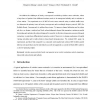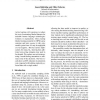77 search results - page 3 / 16 » Reducing the Need for Double Annotation |
CVPR
2012
IEEE
11 years 8 months ago
2012
IEEE
The use of statistical pattern recognition models to segment the left ventricle of the heart in ultrasound images has gained substantial attention over the last few years. The mai...
EMNLP
2008
13 years 7 months ago
2008
A human annotator can provide hints to a machine learner by highlighting contextual "rationales" for each of his or her annotations (Zaidan et al., 2007). How can one ex...
FM
2001
Springer
13 years 10 months ago
2001
Springer
A static program checker that performs modular checking can check one program module for errors without needing to analyze the entire program. Modular checking requires that each m...
MOBIHOC
2005
ACM
14 years 5 months ago
2005
ACM
We address the challenges of bursty convergecast in multi-hop wireless sensor networks, where a large burst of packets from different locations needs to be transported reliably an...
EMNLP
2004
13 years 7 months ago
2004
Active learning (AL) promises to reduce the cost of annotating labeled datasets for trainable human language technologies. Contrary to expectations, when creating labeled training...


